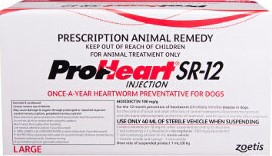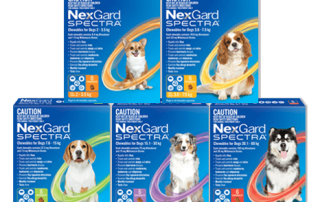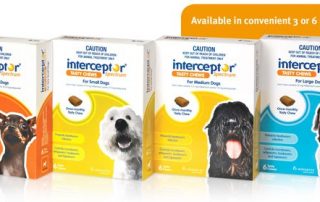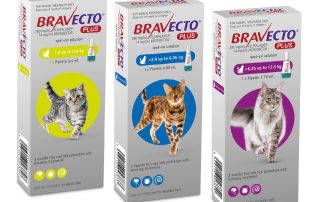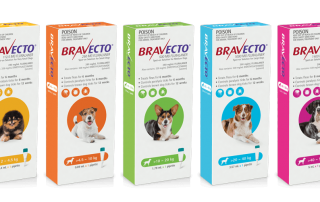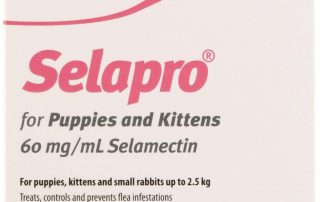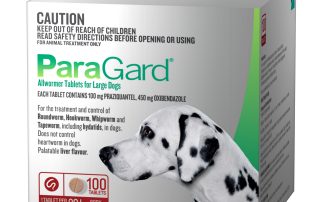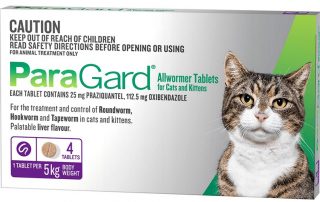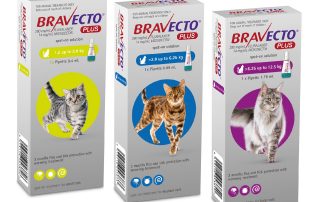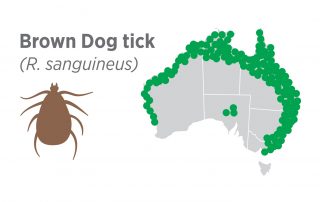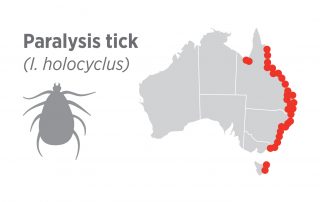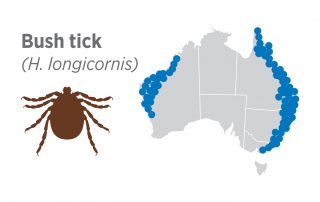There are literally hundreds of products on the market that kill parasites, so it easy to become confused on what to use!
At the Old Reynella Veterinary Clinic we stock what we believe to be the best on the market in regards to ease of use, efficacy and cost.
We stock topical and oral products, as well as the Proheart SR12 heartworm prevention injection for dogs. Some products are administered monthly, 3 monthly or annually.
The main question we are asked is ‘What parasites do we need to protect against?’. The following are the parasites we recommend treating against. The main thing to keep in mind is that is it much easier and cheaper to prevent against parasites than to treat for them when they are an issue..
Heartworm:
Heartworm is a worm that as it’s name suggests, affects the heart. It is transferred by mosquitos, so even indoor pets are not safe and it almost always results in permanent heart damage if not death of the affected pet. It is a bloodborne parasite NOT an intestinal parasite, which is an important distinction when selecting a preventive product.
Signs and symptoms of heartworm can include lethargy, exercise intolerance, coughing, decreased appetite and an enlarged abdomen. If heartworm infection is possible, an inhouse blood test is performed. If a positive result is returned, more extensive blood screening as well as radiographs and ultrasound may also be required. Heartworm is a reportable disease in canines.
Prevention of heartworm is the key. Treatment options for the disease are limited, expensive and may not result in success.
Puppies should be started on a heartworm prevention program from 12 weeks of age.

Fleas:
Fleas are small, blood sucking insects that love warm, humid environments. Signs of flea infestations can include itchiness, skin irritation, fur loss and irritability caused by constant discomfort. Fleas are small, agile critters and as such you are only likely to see them on your pet if there is a large population.
Adult fleas that bite your pet only make up 5% of the flea population. 95% of the flea population is environmental: living in amongst their bedding, the carpet, flooring, etc.
As well as being very irritating to your pet, they can cause an allergic reaction known as Flea Allergy Dermatitis. This is caused by a reaction to the flea’s saliva. Pets often experience severe itching and as a result, suffer from hair loss and trauma to the skin from biting and constant scratching.
Prevention is the key when it comes to fleas. Fleas were once a more seasonal nuisance but with the changes in weather, heating in homes and the fact that pets spend far more time as part of the family they seem to be an all-year-round issue now. It takes a minimum of 3 months consecutive treatment to break the flea lifecycle. It is very important that ALL pets in the house are treated, whether you have sighted fleas on them or not. Oral preventatives have shown the best efficacy on the market, but as some pets are hard to tablet, there are also topical applications available.
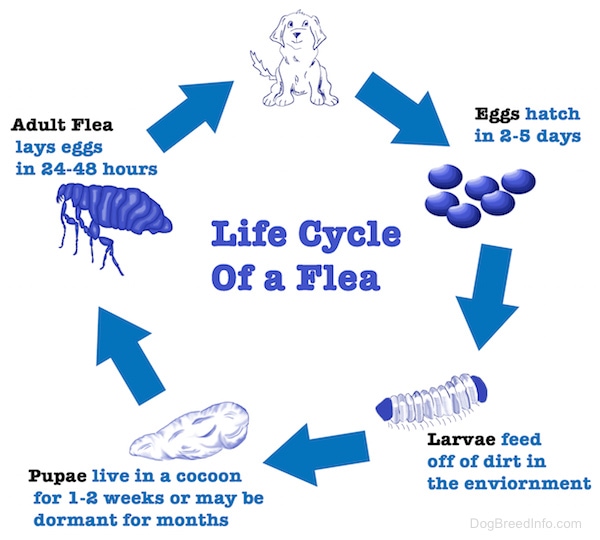

The Do’s of Flea Treatment:
– Do vacuum regularly. When you are seeing fleas on a pet, they account for only 5% of the infestation. For each flea you see on an animal there will be many more eggs, larvae and pupae hidden in the pet’s environment, such as:
– cracks in floor boards
– deep in the carpet pile
– in the family sofa
– in the pet’s bedding
– Do put a flea collar from the supermarket in the vacuum bag for extra killing power (not on your pet!) You can also use a insect surface spray after vacuuming to kill any fleas around.
– Do wash all your pet’s bedding in boiling water (no detergent required) and/or hang them in the hot sun to kill the egg and larvae stages.
– Do treat all pets in the household—not just the ‘itchy’ one. If you have a cat that wanders around but your dogs are getting the flea treatment, you can bet the cat will still be bringing in fleas. All pet’s require treatment, or you will not resolve the flea problem.
– Do use a product that kills quickly and breaks the flea lifecycle. We stock several products that are quick and effective against fleas, and above all SAFE. You will likely need to use several months of treatment if the environmental flea burden is heavy.
The Don’ts of Flea Treatment:
– Don’t wash your pets with flea washes or shampoos. They only make an itchy pet even itchier and don’t have any residual effect. Put simply, once your pet is dry after shampooing, they can pick fleas up once more within 24 hours.
– Don’t bother using flea bombs. As mentioned previously, fleas like to live in hidden places, which the bombs have difficulty reaching. They may kill the odd one or two, but not enough to be worth the toxins and trouble.
– Don’t use flea powders. Much the same as flea shampoos, powders have little residual effect.
– Don’t use ’permethrin’ or ‘pyrethrum’ flea products — ESPECIALLY with cats. These chemicals are HIGHLY TOXIC even at low doses. Even treating your dog with one of these products can lead to cross contamination and be lethal to your cat. If you are unsure, call to ask for advice first. Again, we are happy to help.
– Don’t believe that if you can’t see them, you don’t have fleas. These last 3 years have seen exceptional numbers of fleas causing problems all year round—which is very unusual. This year promises to be just as bad. Prevention is always better than cure, treat now!
Flea Prevention Products for dogs; click the pictures to read more:
Flea Prevention Products for Cats; click the pictures to read more:
Flea Prevention Products for Rabbits and Ferrets:
Intestinal Worms:
Gastrointestinal worms affect both cats and dogs, and most importantly people! Some are contracted in the environment (it’s as simple as walking through an infected space); others are ingested or passed on by their mother via the placenta or milk. The most common worms we treat against are the hookworm, roundworm, whipworm (dogs) and the hydatid and flea tapeworm.
Common signs of worms can include but is not limited to a bloated abdomen, vomiting, diarrhoea, dehydration, appetite changes, itchy bottom or visualisation of the adult worms around the anus or in faeces.
Intestinal worming products are sold based on your pets body weight, and for most adult dogs and cats, they are given every 3 months for life. For pocket pets like rabbits and ferrets, regular worming should also be considered.
Please be aware that Heartworm is not an intestinal worm – it is a blood-borne parasite passed by mosquitoes, so will require a different type of treatment.
For dogs, we have a variety of tablets available. The dose required is dependent on their body weight and their age.
For cats, there are tablets or a spot-on treatment available. The spot-on lasts for three months but is more costly than a worm tablet. Dosing for cats is also dependent on body weight.
Puppies and Kittens require a different worming schedule as they are much more susceptible to picking up worms from the environment. They often can carry a worm burden they pick up in the uterus from their mother. Their schedule is as follows:
- Every 2 weeks up until the age of 12 weeks
- Once a month up until 6 months of age
- Every 3 months thereafter.
For Rabbits, like dogs and cats they also require 3 monthly worming. As they eat a lot of food from the ground, their risk of exposure to the ova (egg) stages of intestinal worms is far greater.
For Ferrets, routine intestinal worming is not required unless you suspect an infestation. Symptoms of intestinal worms can include some of the following:
- presence of adult worms in their faeces,
- loss of weight and coat condition,
- mucousy stools or
- ravenous appetite, sometimes with concurrent weight loss.
- bloated stomach
If your pet ferret is suspected of carrying a worm burden, a faecal sample will be tested and the appropriate anthelmintic will be dispensed.

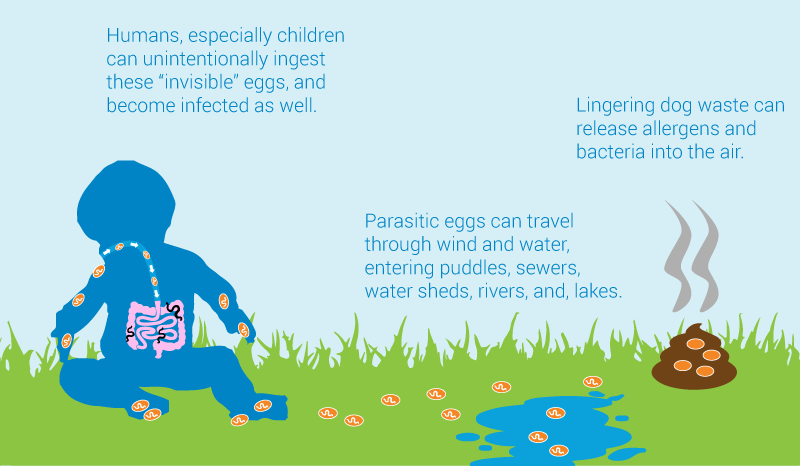
Intestinal Worming Products for Dogs, click the image to read more:
Intestinal Worming Products for Cats, click the image to read more:
Intestinal Worming Products for Rabbits and Ferrets, click the image to read more:
Ticks:
In Adelaide, we are lucky that we do not see many cases of tick related diseases. Ticks however are a big issue in the other states of Australia. It is very important that prior to taking your pet with you on any holidays, that you make sure their parasite prevention covers ticks.
There are three types of ticks: The Brown Tick, the Bush Tick and the deadly Paralysis Tick.
The Brown Dog Tick and Bush Tick often attach themselves around the ears or between the toes. In high numbers they can cause anaemia. They can also spread disease.
The Paralysis Tick can be deadly. As the tick feeds, it injects a paralysing toxin into the bloodstream. These toxins affect the muscles, including the muscles that allow them to breathe. Paralysis Ticks are grey and range in size from a pin head to a pea. Ticks will attach themselves to pets in the environment. They cannot fly or jump. Symptoms include unusual bark, wobbly legs, vomiting and unusual breathing. It can take several days before symptoms appear. Treatment will depend on the level of paralysis. Immediate treatment is required.
If you find yourself travelling through an area that is known to have ticks, ensure you check your pet daily, especially their feet and ears, but they can lodge anywhere.
There are monthly oral or topical products available as well as a 3 monthly chewable suitable for the treatment of ticks. Some products may require increased doses to ensure effective prevention.
Tick Prevention Products for Dogs, Click on image to read more:
Tick Prevention Products for Cats, click to read more:
Ear Mites:
Ear mites (most commonly Otodectes cynotis) are microscopic parasites that pets can pick up from the environment. They cause inflammation and discomfort in the ear, creating a nasty smell in the ear canals and excessive dark brown discharge. Your pet may shake their head, scratch excessively at the ear and even start yelping when being handled around the head. Ear mites are common in kittens and puppies but any species at any age can be affected.
Mites are diagnosed by sampling from the ear and examination under the microscope. If you suspect the presence of ear mites, treatment is advised as soon as you suspect infection to prevent every pet in your household becoming a host.

Mange:
There are two types of parasites that cause mange; demodex and sarcopties mites. Alternative names for these can include Fox Mange or Scabies. Both are microscopic and burrow into the skin layer, causing intense itchiness and hair loss. Sarcoptic mange can pass from pet to human.
Mange is diagnosed from taking a skin scraping and examining it under the microscope. This is done by using a small amount of oil and scalpel blade and gently scraping layers of the skin onto a glass slide that can then be examined. Unfortunately, being that these mites are very small, skin scraping may not always yield a positive result. If this is the case, the vet may repeat the scraping or start treatment regardless.
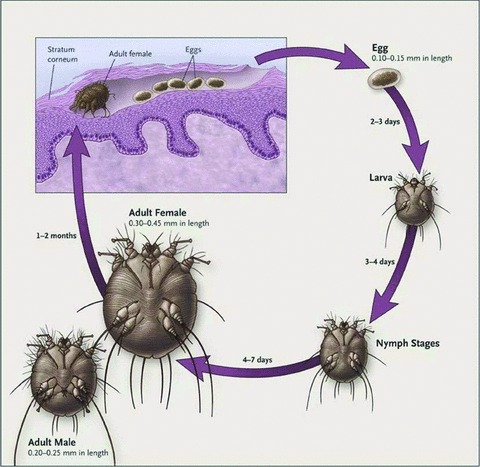
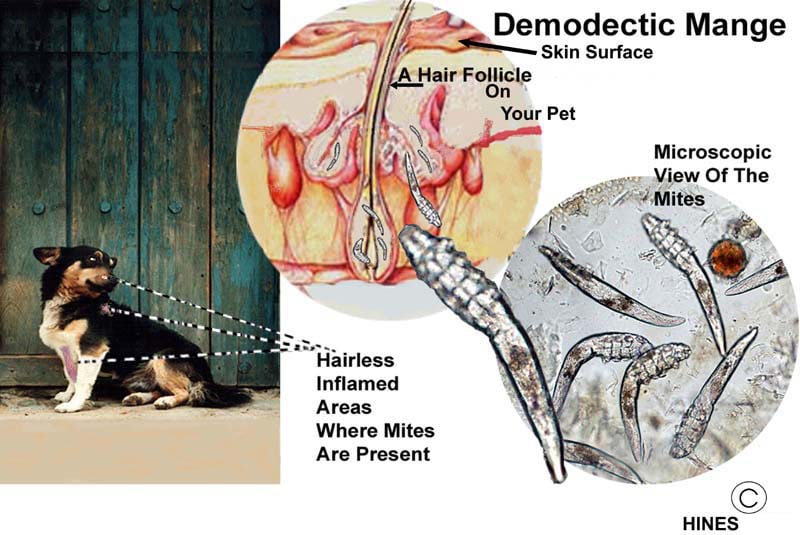
Ringworm:
Contrary to what the name suggests, Ringworm is NOT a parasite. Rather it is a fungal infection caused by dermatophytes on the skin. Ringworm commonly causes dandruff-like scaled lesions, sometimes in a circular shape. It is highly contagious, and will often pass from pet to human, or from pet to pet.
There are some ‘over the counter’ medications available for treatment of Ringworm; if you suspect your pet may be affected, please contact the clinic for more advice.


